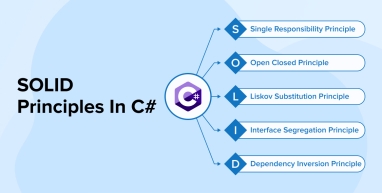
For scalable and maintainable code in C#, knowledge and understanding of SOLID principles are essential. The five object-oriented design principles help developers build better software systems by promoting flexibility and reducing the risk of bugs or code duplication.
In this blog, we will learn what the SOLID principles are, why they are important, and how they benefit C# developers. Whether you’re an individual coder or working in a .NET development company, mastering the SOLID principles can significantly improve your application architecture and increase the chances of long-term project success. We will also explore their benefits and limitations in real-world scenarios, along with practical code examples.
1. What are the SOLID Principles?
SOLID principles are a set of five essential object-oriented programming guidelines that help developers write clean, maintainable, and scalable code. These concepts were introduced by Robert C. Martin (Uncle Bob) and are widely adopted in modern software development, especially in C#.
Let’s elaborate on the five design principles and understand better:
1.1 S: Single-Responsibility Principle
In the words of Robert C Martin, “A class should have only one reason to change, meaning that changes to a single part of the software’s specification should affect only that class.” We mean to say that every class must have a single responsibility. If a particular functionality fails, the issue is isolated to that class, making debugging easier and reducing the risk of affecting other parts of the code. SRP supports encapsulation by ensuring that each class handles only one specific responsibility, making it easier to manage and protect data. When all relevant data and methods are grouped in a focused class, adding getter and setter methods helps maintain proper access control, thereby achieving encapsulation.
Before proceeding to the example, take a look at Milan Jovanović’s tweet about the Single Responsibility Principle.
1. 𝗦𝗶𝗻𝗴𝗹𝗲 𝗥𝗲𝘀𝗽𝗼𝗻𝘀𝗶𝗯𝗶𝗹𝗶𝘁𝘆 𝗣𝗿𝗶𝗻𝗰𝗶𝗽𝗹𝗲 (𝗦𝗥𝗣)
— Milan Jovanović (@mjovanovictech) July 17, 2023
A class should have only one reason to change. In other words, a class should have a single, well-defined responsibility. That class should entirely encapsulate responsibility.
Example in C#
Consider a Report class that is responsible for generating reports, exporting reports to PDF, saving reports to a database, and emailing reports. This violates SRP.
Bad Example:
public class Report { public string Title { get; set; } public string Content { get; set; } public void Generate() { /* generate logic */ } public void ExportToPDF() { /* PDF logic */ } public void SaveToDatabase() { /* DB logic */ } public void EmailReport() { /* email logic */ } } |
This class does too many things — its generation, exporting, storage, and communication which violates SRP. Let’s separate classes for its single responsibility.
Good Example:
public class Report { public string Title { get; set; } public string Content { get; set; } public void Generate() { /* just prepare content */ } } public class ReportExporter { public void ExportToPDF(Report report) { /* PDF logic */ } } public class ReportSaver { public void Save(Report report) { /* DB save logic */ } } public class ReportSender { public void Email(Report report) { /* email logic */ } } |
Explanation:
You can see that all the classes in the above code have well-defined responsibilities.
- The Report class handles data and report-generation logic; therefore, changes to the report will affect only this class.
- The ReportExporter class exports reports to PDF.
- The ReportSaver saves the reports to a file or database.
- The ReportSender manages sending reports by email.
1.2 O: Open/Closed Principle
The second design principle states, “A software class, module, or function should be open for extension but closed for modification”. This means you should be able to add new features to a class without modifying the code that already exists within it. One effective way to achieve this is through polymorphism, where new functionality is introduced by creating new subclasses or implementations instead of altering the base classes.
Using interface inheritance is a preferred method because it encourages loose coupling between components. By defining behavior through interfaces, you can introduce new classes that implement these interfaces, adding new features without affecting the existing codebase. In contrast, relying heavily on class inheritance can lead to tight coupling, where changes in the base class may unintentionally impact all derived classes.
This principle ensures that changes in the system are localized, reducing the chances of introducing bugs into previously working code. In practice, when designing software, developers should focus on writing components that can be extended with new code, rather than modifying existing logic.
Implementation Guidelines for the OCP in C#
- Implement new features by creating derived classes from a base class, avoiding any changes to the existing base class code.
- Ensure that client code interacts through interfaces or abstract classes, which provide flexibility and hide implementation details.
- When new requirements arise, extend the system by adding new subclasses rather than modifying existing class logic.
- Keep the original class unchanged to maintain stability and lessen the possibility of encountering bugs.
Drawbacks of Not Adhering to the Open-Closed Principle in C#
- Adding new logic to existing classes or functions requires retesting both old and new features, which increases testing effort.
- Violating the Open-Closed Principle reduces modularity, breaks the Single Responsibility Principle, and makes maintenance difficult.
- When a single class handles multiple functionalities, it becomes harder to manage, update, or debug because changes in one part can unintentionally affect others.
Example in C#
Let’s assume we want to support multiple export formats.
Bad Example:
public class ReportExporter { public void Export(Report report, string format) { if (format == "PDF") { /* Export to PDF logic */ } else if (format == "Excel") { /* Export to Excel logic */ } else if (format == "Word") { /* Export to Word logic */ } } } |
Every time a new format is added, we need to modify this class. Now let’s check how OCP resolves this issue.
Good Example:
public interface IReportExporter { void Export(Report report); } public class PdfReportExporter : IReportExporter { public void Export(Report report) { /* PDF export */ } } public class ExcelReportExporter : IReportExporter { public void Export(Report report) { /* Excel export */ } } public class ReportExportService { public void ExportReport(Report report, IReportExporter exporter) { exporter.Export(report); } } |
Explanation:
In the code above, the ReportExportService class does not implement the export process; it simply calls an Export() method. To support exporting in formats other than PDF, let’s say Word format, you can create a WordReportExporter class that implements the IReportExporter interface and performs the required operation. This approach eliminates the need to modify existing code and follows polymorphism and interface-based extension.
1.3 L: Liskov Substitution Principle (LSP)
The Liskov Substitution Principle is the third design principle given by Barbara Liskov in 1987. It states that objects of a superclass should be replaceable with instances of their subclasses without affecting the correctness of the program. In simple terms, wherever a base class is expected, a derived class should be able to substitute it without changing the intended behavior. Therefore, subclasses must produce consistent output for the same input as the base class.
In C#, LSP is especially important when implementing inheritance or interfaces. If a subclass overrides methods in a way that changes the expected behavior or introduces side effects, it can lead to unexpected and incorrect program behavior. For example, if a derived class throws an exception for a method that works correctly in the base class, it violates LSP and can break client code.
Rules for the Liskov Substitution Principle
- A subclass must fully implement the behavior of the base class, meaning it shouldn’t leave any inherited methods unimplemented or raise a “NotImplementedException.”
- When overriding a method, the subclass must use the same method signature, including parameters, to ensure consistent behavior and maintain compatibility.
Example in C#:
Let’s define a base class ReportFormatter, and inherit it into PdfFormatter and BrokenFormatter, where in BrokenFormatter, we will throw a method-not-implemented- exception.
Bad Example:
public abstract class ReportFormatter { public abstract string Format(Report report); } public class PdfFormatter : ReportFormatter { public override string Format(Report report) { return "PDF content"; } } public class BrokenFormatter : ReportFormatter { public override string Format(Report report) { throw new NotImplementedException(); // violates LSP } } |
Here, BrokenFormatter violates LSP, because this derived class throw method does not implement an exception when we replace it with the base class.
Good Example:
public abstract class ReportFormatter { public abstract string Format(Report report); } public class PdfFormatter : ReportFormatter { public override string Format(Report report) { return "PDF Content"; } } public class WordFormatter : ReportFormatter { public override string Format(Report report) { return "Word Content"; } } |
Explanation:
You can see that the derived classes PdfFormatter and WordFormatter override the Format() method of the abstract base class ReportFormatter. Therefore, they can be used wherever a ReportFormatter is required, preventing a violation of the Liskov Substitution Principle (LSP).
We can also apply the Interface Segregation Principle (ISP) here. Extract the Format() method from the base class into a separate interface and implement that interface only in derived classes that provide formatting logic. The ReportFormatter does not need to be an abstract class; define it as an interface to eliminate unused method implementations and simplify the design.
1.4 I: Interface Segregation Principle (ISP)
The Interface Segregation Principle states, “Many client-specific interfaces are better than one general-purpose interface.” Here, the aim is to create small, focused interfaces rather than a single interface that includes too many unrelated functionalities. The classes implementing such all-in-one interfaces are forced to implement unnecessary methods, which increases their complexity and size. According to the Interface Segregation Principle (ISP), a class should implement an interface only if it requires the methods declared within that interface. This ensures that changes to an interface affect only the classes that implement it, without impacting other classes.
We studied the first SOLID principle, which states that every class must be associated with a single functionality. The same applies to interfaces: each interface should be designed with a specific purpose in mind. Additionally, an interface with too many methods can lead to classes that have multiple functionalities, thus violating the Single Responsibility Principle.
Bad Example:
Suppose you have a large interface that does too many things, such as generating a report, exporting to PDF, saving to a database, and sending an email, etc.
public interface IReportProcessor { void Generate(); void Export(); void Save(); void SendEmail(); } |
Now, whenever we inherit this interface we have to inherit all its methods in its derived class, while sometimes I don’t want to inherit all methods. So, let’s resolve this issue with the ISP.
Good Example:
public interface IReportGenerator { void Generate(); } public interface IReportExporter { void Export(Report report); } public interface IReportSave { void Save(Report report); } public interface IReportSender { void SendEmail(Report report); } public class SimpleReport : IReportGenerator { public void Generate() { // Report Generate logic here } } public class EmailReportSender : IReportSender { public void SendEmail(Report report) { // Send Email Report logic here } } |
Explanation:
The above code declares Generate(), Export(), Save(), and SendEmail() methods across four interfaces. The SimpleReport class requires only the Generate() method, so it just implements the IReportGenerator interface. Similarly, the EmailReportSender class deals only with emailing reports, so it only implements the IReportSender interface.
1.5 D: Dependency Inversion Principle (DIP)
The Dependency Inversion Principle (DIP) aims to hide implementation details by relying on abstractions rather than concrete implementations. The principle conveys two things:
- There must not be a direct relation between high-level modules and low-level modules. In simple terms, higher classes should rely on abstractions of lower-level classes, such as interfaces or abstract classes, without depending on their actual details.
- Abstractions should not depend on implementation details; rather, implementation details should depend on abstractions.
In software design, low-level modules handle specific, detailed tasks, while high-level modules focus on broader, complex logic. When these modules are tightly coupled, changes in one often require modifications in the other, increasing maintenance effort and the risk of errors.
To reduce tight coupling, the Dependency Inversion Principle (DIP) encourages introducing abstractions that decouple high-level and low-level components. This decoupling allows individual modules to be changed or replaced without impacting the entire system, resulting in more flexible, maintainable, and scalable software. By depending on abstractions, implementation details remain hidden from higher-level modules, promoting a clear separation of concerns.
This principle complements other SOLID principles, such as the Liskov Substitution Principle and the Open/Closed Principle, which together help create systems that are easier to extend and modify without breaking existing functionality. Applying DIP effectively improves code quality and reduces the complexity of managing dependencies within a project.
Bad Example:
public class ReportService { private PdfReportExporter _exporter = new PdfReportExporter(); public void ExportReport(Report report) { _exporter.Export(report); } } |
Here, ReportService is tightly coupled to PdfReportExporter; instead of that, we can create an interface IReportExporter and inject it dependency into ReportService, like below.
Good Example:
public interface IReportExporter { void Export(Report report); } public class ReportService(IReportExporter exporter) { private readonly IReportExporter _exporter = exporter; public void ExportReport(Report report) { _exporter.Export(report); } } |
Then inject any implementation:
var service = new ReportService(new PdfReportExporter()); |
Explanation:
In the code above, the ReportService class depends on the IReportExporter interface rather than a concrete implementation, like the PdfReportExporter. This loose coupling between ReportService and IReportExporter allows for injecting different implementations, for example, testing or alternate export formats.
2. Benefits of the SOLID Principle in C#
The following are the advantages of applying SOLID design principles in C#:
2.1 Improved Extensibility
SOLID principles enhance extensibility by promoting modular and flexible code structures. They encourage designing components that are open for extension but closed for modification, enabling the easy addition of new features without changing existing code. This reduces the risks of errors and simplifies maintenance, making systems adaptable to evolving requirements.
2.2 Debugging
SOLID principles promote clear, organized, and modular code. Each component has a single responsibility and well-defined interfaces, making it easier to isolate issues. This reduces complexity, allowing developers to quickly identify and fix bugs without affecting other parts of the system.
2.3 Parallel Development
SOLID principles facilitate a modular approach to software development by encouraging independent, well-defined modules. Clear interfaces and responsibilities enable multiple developers to work simultaneously on different parts without conflicts, speeding up progress and improving collaboration while minimizing integration issues.
2.4 Increased Scalability
By separating concerns and relying on abstractions, systems can easily accommodate growth and new features without extensive rewrites, ensuring that expanding the application remains efficient and manageable as demands increase.
2.5 Enhanced Maintainability
SOLID principles ensure that code is organized into clear, focused modules with well-defined responsibilities. This structure makes the code easier to understand, update, and fix without introducing errors. It also reduces complexity and enables efficient long-term management of software projects.
3. Challenges Associated with SOLID Principles
Below are a few challenges of the SOLID principles:
3.1 Learning Curve
Understanding and correctly applying these design rules requires time and experience, which can slow initial development. This steep learning curve may cause confusion and misuse, hindering productivity and increasing the risk of errors early on.
3.2 Overhead For Small Projects
Applying SOLID principles to small projects can create unnecessary overhead. The added complexity and extra design effort may slow development without providing significant benefits, as simple projects often don’t need such a detailed structure. This can lead to wasted time and resources, making SOLID less efficient for small-scale tasks.
3.3 Potential Performance Impact
Using SOLID principles can sometimes affect performance due to increased abstraction and the creation of additional objects or layers. This added complexity may lead to slower execution or higher memory usage. The overhead from strictly adhering to SOLID principles can reduce overall efficiency and responsiveness in some cases.
4. Final Thoughts
The comprehension and implementation of the SOLID principles in C# promote better design and reduce software complexity. By following SOLID, programmers can build flexible applications that are easier to test, maintain, and extend over time. Whether you’re a beginner or an experienced developer, incorporating these principles into your coding practices will improve the quality of your projects and make collaboration with other developers smoother. The SOLID principles form the foundation of professional C# development.






Comments
Leave a message...